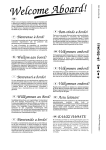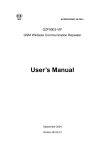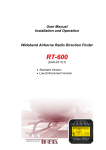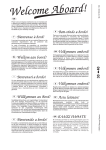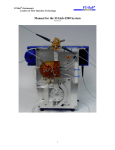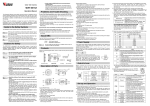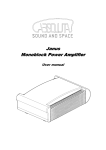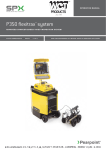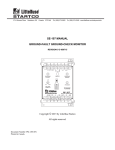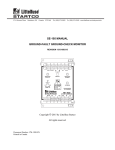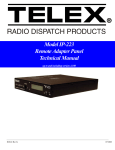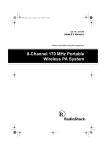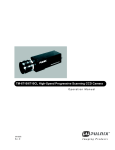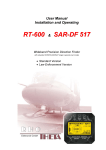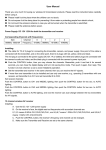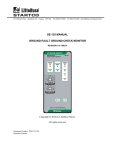Download - SUPSI Space Lab
Transcript
Scuola universitaria professionale della Svizzera italiana Dipartimento Tecnologie Innovative SSL SUPSI SpaceLab – TIsat-1 Ground Segment Team Operative Manual SUPSI SpaceLab 20.03.2010 (Doc. SSL-100320_DI-en) Revisions Rev. 0 1 1.1 Date 20.03.2010 12.05.2010 11.06.2010 Author IBo IBo/PCe IBo/PCe Date of printing: July 11, 2010 Description First version. Reviewed draft. Production (launch time) version. Contents 1 Introduction 5 2 Space Segment 2.1 An Overview of TIsat-1 . . . . . . . . . . . . . 2.2 COMM Subsystems Overview . . . . . . . . . . 2.2.1 Mission Sequence . . . . . . . . . . . . . 2.2.2 Post Separation Operation . . . . . . . . 2.2.3 Nominal RF Operating Scheme . . . . . 2.2.4 Operating sequences . . . . . . . . . . . 2.2.5 Beacon . . . . . . . . . . . . . . . . . . 2.2.6 Transceiver . . . . . . . . . . . . . . . . 2.3 Downlink . . . . . . . . . . . . . . . . . . . . . 2.3.1 Beacon CW Type of Modulation . . . . 2.3.2 Alinco Audio-Morse Type of Modulation 2.3.3 Alinco Audio-FSK Type of Modulation 2.3.4 Alinco Audio-PSK Type of Modulation 2.3.5 Beacon Packet Architecture . . . . . . . 2.3.6 Alinco Morse Packet Architecture . . . . 2.3.7 Alinco FSK Packet Architecture . . . . 2.3.8 Alinco PSK Packet Architecture . . . . 2.3.9 Beacon Packet Coding Details . . . . . . 2.3.10 Alinco Morse Coding Details . . . . . . 2.3.11 Alinco FSK Coding Details . . . . . . . 2.3.12 Alinco PSK Coding Details . . . . . . . 2.4 Uplink . . . . . . . . . . . . . . . . . . . . . . . . . . . . . . . . . . . . . . . . . . . . . . . . . . . . . . . . . . . . . . . . . . . . . . . . . . . . . . . . . . . . . . . . . . . . . . . . . . . . . . . . . . . . . . . . . . . . . . . . . . . . . . . . . . . . . . . . . . . . . . . . . . . . . . . . . . . . . . . . . . . . . . . . . . . . . . . . . . . . . . . . . . . . . . . . . . . . . . . . . . . . . . . . . . . . . . . . . . . . . . . . . . . . . . . . . . . . . . . . . . . . . . . . . . . . . . . . . . . . . . . . . . . . . . . . . . . . . . . . . . . . . . . . . . . . . . . . . . . . . . . . . . . . . 7 7 8 8 8 8 9 11 11 12 12 12 13 14 14 19 19 20 28 37 37 38 42 3 TIsat Demodulator User’s Manual 3.1 Basic Concepts . . . . . . . . . . . . . . . 3.1.1 Download . . . . . . . . . . . . . . 3.1.2 Soft- and Hardware Requirements 3.1.3 Workspace . . . . . . . . . . . . . . 3.1.4 Logs and Feedback . . . . . . . . . 3.2 Installation . . . . . . . . . . . . . . . . . 3.3 Usage . . . . . . . . . . . . . . . . . . . . . . . . . . . . . . . . . . . . . . . . . . . . . . . . . . . . . . . . . . . . . . . . . . . . . . . . . . . . . . . . . . . . . . . . . . . . . . . . . . . . . . . . . . . . . . . 43 43 43 43 44 44 46 50 3 . . . . . . . . . . . . . . . . . . . . . SSL-100320_DI-en CONTENTS Acronyms and Terms AGC CCR DoL ECC EOC EOD EPS OBC OPR GS PV RFPC RX TX TU CBD WPM SSL Automatic Gain Control Capture and Compare Registers [?] Days of Life (in-orbit mission duration) Error Correcting Code End Of Charge (related to batteries) End Of Discharge (related to batteries) Electric Power Supply On-Board Computer Orbit PRofile (related to datasets in telemetry) Ground Station Photovoltaic RF Power Checker Receive or Receiver Transmit or Transmitter Timing Unit CPU Boot Delay: the time between boot of the CPUs as assigned by the TU. Words per Minute, the Morse transmission rate measure. 4 / 50 GST Operative Manual Chapter 1 Introduction TIsat-1 is the first staff and student made satellite of SUPSI-SpaceLab. For communication TIsat-1 relies on amateur radio frequencies which were coordinated with the International Amateur Radio Union (IARU). This document describes 1. the radio communication system, 2. the modulation methods, 3. the communication frame architecture and 4. the frame details of TIsat-1. This information will enable decoding of TIsat-1’s signals even without the specific software that SUPSI-SpaceLab has prepared for the mission. Further a short installation and user guide for the demodulation and decoding software provided by SUPSI-SpaceLab is given. 5 SSL-100320_DI-en SSL CHAPTER 1. INTRODUCTION 6 / 50 GST Operative Manual Chapter 2 Space Segment 2.1 An Overview of TIsat-1 Figure 2.1 shows the structure of TIsat-1 along with the naming convention for the sides. Four antennas are depicted: TIsat-1 actually carries only two of the four antennas1 . Figure 2.1: TIsat-1: structure. 1 Emission efficiency was experimentally found to be better with only two antennas. 7 SSL-100320_DI-en 2.2 CHAPTER 2. SPACE SEGMENT COMM Subsystems Overview TIsat-1 carries two radio devices working in the UHF respectively in the VHF band. A home grown beacon transmitter is dedicated to downlink short telemetry (i.e. essential information) and operates in UHF (437.305 MHz) with CW modulation. The beacon is also used as emergency radio and first communication device, just after the launch. The second device is a commercial FM transceiver (Alinco) used for up- as well as for down-link. It is adapted to handle several audio tone modulation schemes providing an higher bit-rate than the beacon. This radio is used to transmit the full telemetry in the VHF band (145.980 MHz). The two radios relay each other during TIsat-1’s mission with a time-slice logic. 2.2.1 Mission Sequence The four stage PSLV rocket is expected to cut-off thrust of PS4 (fourth stage) at liftoff +1034.2s. This time is called T6. TIsat-1 will separate from the Launch Vehicle (LV) at T 6 + 135.4s. Up to separation time the spacecraft is powered off. 2.2.2 Post Separation Operation After separation, i.e. the spacecraft leaves the XPOD, complying with the CDS2 rev. 11, TIsat-1 will 1. wait for at least 900s before deploying antennas. While waiting, TIsat-1 will sample the internal temperature and will activate the deployment system only if the temperature is above 0o C, but not later than 130 min after separation. No communication will take place during this time. 2. After antenna deployment, for the next 900s, short beacon transmission are allowed. The Morse string "tisat1 hb9de" is transmitted. 3. After 1800s (30 min) nominal spacecraft operation is entered. 2.2.3 Nominal RF Operating Scheme The two downlink devices (Beacon and FM transceiver) alternate each orbit. During even orbits the beacon is used, while the FM transceiver is used during the next (odd) orbit. During the FM transceiver orbit, a data packet transmission is repeated for 25 seconds each minute, queuing 4 PSK packets with 1 FSK packet. Find additional information on packet encoding and transmission in the next sections. The beacon transmission rate is toggled from slow (16 WPM) to fast-rate (100 WPM) every 32 orbits. 2 CubeSat Design Specification. SSL 8 / 50 GST Operative Manual CHAPTER 2. SPACE SEGMENT 2.2.4 SSL-100320_DI-en Operating sequences COMM operating sequences are tied to the Operating Modes and Operating Cycles of the spacecraft. The spacecraft Operating Modes TIsat-1 is programmed to periodically execute three basic operations during its nominal life: 1. perform housekeeping measurements and procedures and payload tests; 2. transmit data to the Ground Stations; 3. receive commands. The firmware of the OBC is able to self configure the satellite depending on which operation has to be executed. A fixed timeslot is allotted to each operation; when the slot times out the current operation is terminated and the next is started. The software and hardware configuration related to each operation is called Operating Mode. There are five Operating Modes: n. 1 2 3 4 5 Operating Mode Housekeeping Transmission with FM radio Transmission with beacon Reception Sleep Timeslot (s) 15 25 25 20 25 Notes TX_FM mode TX_Beacon mode RX mode Houskeeping mode: the CPU basically reads the sensors and stores the results in memory. This operating mode takes 15 seconds. No radio transmission is activated during this time. When the housekeeping time expires, TIsat-1 enters one of two transmission modes, unless energy saving is necessary, in which case the satellite enters Sleep mode. TX_FM mode: this mode is entered during even numbered orbits and lasts 25 seconds. The satellite uses the FM radio going through its modulations schemes and packets: four operating cycles with PSK and one with AM-FSK packets. The same packet is repeated so many times as needed to fill the 25 seconds of the TX mode. After that the RX mode is activated. TX_Beacon mode: this mode is entered during odd numbered orbits and lasts 25 seconds. The satellite uses the beacon (CW) to send the specific packets at two different data rates. Slow rate: the transmission scheme is periodic in five steps 1. transmission of the callsign; 2. Beacon short packet type 1; GST Operative Manual 9 / 50 SSL SSL-100320_DI-en CHAPTER 2. SPACE SEGMENT 3. Beacon short packet type 2; 4. Beacon short packet type 3; 5. Beacon short packet3 type 4. The packets are repeated to fill the 25 seconds of the mode timeslot. Fast rate: the Beacon ”Complete packet” described in section 2.3.5 is repeated over and over during the 25 seconds of the mode timeslot. After that the Rx mode is activated. Sleep mode: in this mode no activity occurs for 25 seconds. This is the power saving mode. It is activated either in eclipse, in case of emergency and over equatorial latitudes, where the satellite has the maximum exposition of the solar panels. RX mode: the FM transceiver is turned on in receive mode and the satellite waits for commands from the Ground Stations. If no command is received within 20 seconds, the mode is terminated, otherwise the satellite keeps in RX mode until a "End of RX" command is received or the processor timeslot (max 5 minutes) expires. The RX mode is the only mandatory mode for each cycle; its duration is at least 20s every 40s. The spacecraft Operating Cycles A sequence of three operating modes, that matches the basic operations of the satellite, is called a Operating Cycle. Each Operating Cycle takes one minute to execute. Figure 2.2: Operating modes (bubbles) and cycles (closed paths) of TIsat-1. Note (fig. 2.2) that any closed path following the oriented edges of the graph represents one possible Operating Cycle and takes 1 minute to execute. 3 Beacon Packets are described in section 2.3.5. SSL 10 / 50 GST Operative Manual CHAPTER 2. SPACE SEGMENT SSL-100320_DI-en The scheduling and execution sequence of the operating modes depends on specific real time constraints. Decisions are based on energy availability, sunlight conditions4 , temperature, estimated position along the orbit, etc. Depending on the situation, there can be cycles without TX state. The Processor Timeslot For redundancy purposes, the OBC of TIsat-1 is built with two independent microcontrollers relaying each other periodically in control of the spacecraft. The time allotted to each processor is called Processor Timeslot and, for TIsat-1, it is set to 5 minutes. During the timeslot the processor executes 5 Operating Cycles. The two microcontrollers are programmed to be functionally identical, so they behave the same way during each one’s timeslot. 2.2.5 Beacon The beacon transmitter is tuned to the RF frequency of 437.305MHz. The output of the transmitter is switched on and off to achieve information transport. This procedure is commonly referred to as CW (Continuous Wave) or OOK (On-OffKeying) modulation. 2.2.6 Transceiver The transceiver used on TIsat-1 is a FM device. Its carrier frequency is set to 145.980MHz according to the IARU coordinated frequency for the spacecraft and is modulated by audio tones injected via the microphone jack. The term modulation used in the following always refers to audio types of modulation. All types of modulation for the transceiver have been implemented in software and are part of the experimental payload for TIsat-1. The audio tones are generated by the OBC. 4 During eclipse the batteries cannot be recharged, therefore the power consumption shall be limited. GST Operative Manual 11 / 50 SSL SSL-100320_DI-en 2.3 2.3.1 CHAPTER 2. SPACE SEGMENT Downlink Beacon CW Type of Modulation The transmission method is based on Morse encoding. The data rates are the same as for the FM transceiver, i.e. 16 WPM at slow rate and 100 WPM at fast rate. 2.3.2 Alinco Audio-Morse Type of Modulation A 880Hz tone of changing duration, interleaved with silence is synthesized by the OBC of TIsat-1 (fig. 2.3) and is injected to the microphone input of the transceiver. Figure 2.3: The Morse modulation. The symbols dot (dit) and dash (dah) are coded with a short / long sound preceded and followed by silence. Silences have different durations depending on their position: inter-symbol, inter-character of the same word, inter-word. The duration for symbols and silences in the scheme adopted for TIsat-1 is reported in table 2.1 (1:2:5 scheme). Object Dot (dit) Dash (dah) Inter-symbol silence Inter-character silence Inter-words silence Duration base unit 3 dots 1 dot 2 dots 5 dots Table 2.1: Morse symbol duration The Morse data rate is expressed in Words Per Minute (WPM), where the reference word is ”PARIS”. Table 2.2 shows the enconding for the standard word. P · − −· A ·− 2 R ·−· 2 I ·· 2 S ··· 2 5 Table 2.2: Morse encoding of standard word "PARIS". The duration of a dot in seconds can be computed as follows. The word "PARIS" contains 10 dots, 4 dashes, 9 inter-symbol silences, 4 intercharacter silences and 1 inter-word silence, which is equivalent to (10 · 1) + (4 · 3) + (9 · 1) + (4 · 2) + (1 · 5) = 44 dots. SSL 12 / 50 (2.1) GST Operative Manual CHAPTER 2. SPACE SEGMENT SSL-100320_DI-en Defining this value as dots-per-word (dpw), one can compute the time per dot as in equation 2.2. 60s T imeP erDot = (2.2) W P M · dpw The Audio-Morse type of modulation for TIsat-1 runs at 16 WPM at slow rate and 100 WPM at fast rate. Dot time for these rates is summarized in table 2.3. Data Rate (WPM) 16 100 Dot time(ms) 85.2 13.6 Table 2.3: Dot time Morse modulation with the FM transceiver has modest throughput compared to the other modulation schemes. 2.3.3 Alinco Audio-FSK Type of Modulation The two logic symbols ’0’ and ’1’ are mapped to the audio tones, 1200Hz and 600Hz. The amplitude of the two tones is different and is tuned to favour the decoding process. The digital raw data is Differential-Manchester encoded prior to modulation. The chosen encoding scheme (fig. 2.4)5 calls for a change at the beginning of each bit cell (regardeless of the data value) and further: Data Value ’1’ ’0’ Center of Bit-Cell No change Change occurs Figure 2.4: The FSK modulation with Manchester data enconding With this modulation TIsat-1 acheives a bit rate BR ≈ 100 bit/s. The minimum and maximum number of uninterrupted full tone periods can be calculated as follows: Nmin = NM AX 5 = 1 BR 1 BR · 1 · ftone 2 · ftone = 2 · Nmin (2.3) (2.4) Documented as Biphase Mark Code in WikiPedia. GST Operative Manual 13 / 50 SSL SSL-100320_DI-en CHAPTER 2. SPACE SEGMENT Nmin numerical values: Nmin_600Hz = Nmin_1200Hz = 2.3.4 1 100 1 100 1 · 600 = 3 2 1 · · 1200 = 6 2 · Alinco Audio-PSK Type of Modulation A tone of 1400Hz is the basis for the PSK modulation. One period of the tone 1 (T = 1400Hz ≈ 714 µs) represents one bit of data. At the occurrence of each data bit of value ’1’, the phase of the tone is reversed (shifted by 180◦ ), otherwise no phase shift is introduced (fig. 2.5). This is actually Differential Phase Shift Keying modulation (DPSK). Figure 2.5: The PSK Modulation (DPSK) With this modulation TIsat-1 acheives a bit rate BR ≈ 1400 bit/s. PSK is used to download the complete telemetry of TIsat-1. 2.3.5 Beacon Packet Architecture The Beacon of TIsat-1 sends a set of instantaneous parameter values using Morse code. In order to make data packets as short as possible the encoding scheme of table 2.4 for every nibble of data6 was chosen. The 16 shortest Morse characters were mapped to the 16 hexadecimal values (0x0 . . . 0xF) possible with 4 bits, i.e. a nibble. For TIsat-1 this is referred to as Morse short-form. Packets The beacon sends six different packets of data. n. Packet Name 1 Callsign 2 3 4 5 6 Battery status Subsystems status Photovoltaic temperature Payload Complete Data Rate (WPM) 16 16 16 16 16 100 Comment Contains HB9DE in plain Morse (no Short-form encoding). Collects all the above information 6 The term nibble is largely used to define different quantities of bits. For this document a nibble is 4 bits. Two concatenated nibbles generate a byte (8 bits). SSL 14 / 50 GST Operative Manual CHAPTER 2. SPACE SEGMENT Nibble Value 0x0 0x1 0x2 0x3 0x4 0x5 0x6 0x7 0x8 0x9 0xA 0xB 0xC 0xD 0xE 0xF SSL-100320_DI-en Character E I T N S A H D R M K U B 5 F L Morse Code · ·· − −· ··· ·− · · ·· −·· ·−· −− −·− ··− − · ·· ····· · · −· · − ·· Length (dots) 1 3 3 5 5 5 7 7 7 7 9 7 9 9 9 9 Table 2.4: Morse short format encoding for TIsat-1 The beacon is thought to be easily heard and understood by anyone with knowledge of the Morse code. Any standard Morse decoding software can be used to automatically put the dit-dah into text. Decoding can be acheived even by hand, following the rules listed in the next sections. SUPSI-SpaceLab provides software to automatically gather, check, save and decode data from TIsat-1. Battery status packet The battery status packet shows the actual temperature and voltage of the two batteries of TIsat-1: a Lithium-Polimer (LiPo, 1400 mAh, 4V, nominal 3.6V) and a Lithium-Ion (LiIon, 2400 mAh, 4V, nominal 3.6 V). The structure of the packet is shown in figure 2.6. Each square (numbered 1 . . . 12) is one of Short-form Morse charactes encoding a 4 bit value (see table 2.4). The first box (Sync) on the left is the synchronization symbol (a non standard Morse symbol). Refer to table 2.5 for decoding. Figure 2.6: Beacon battery status packet GST Operative Manual 15 / 50 SSL SSL-100320_DI-en CHAPTER 2. SPACE SEGMENT Character 1 2-4 5 6-7 8-9 10 11 12-13 Name Packet ID and processor ID Orbit number Approximate latitude Lithium-Polymer Temperature Lithium-Ion Temperature Lithium-Polymer Voltage Lithium-Ion Voltage Checksum Table 2.5: Battery status packet fields. Subsystems status packet Figure 2.7, and table 2.6 summarize the structure of the packet and the information of each field. Figure 2.7: Beacon Subsystems status packet Character 1 2-4 5 6-7 8-9 10-11 12-13 Name Packet ID and processor ID Orbit number Approximate latitude Alinco temperature Beacon temperature OBC temperature Checksum Table 2.6: Subsystems status packet fields Photovoltaic temperature packet Each of the 6 photovoltaic modules of TIsat-1 is monitored by a thermometer. The temperature of the sides X-, Y+ and Z- are available in this packet. The structure of the packet is shown in figure 2.8. Refer to table 2.7 for decoding. SSL 16 / 50 GST Operative Manual CHAPTER 2. SPACE SEGMENT SSL-100320_DI-en Figure 2.8: Beacon Photovoltaic temperatures packet. Character 1 2-4 5 6-7 8-9 10-11 12-13 Name Packet ID and processor ID Orbit number Approximate latitude X- side temperature Y+ side temperature Z- side temperature Checksum Table 2.7: Photovoltaic temperature packet fields Payload packet On each side of TIsat-1, eight thin wire probes are exposed to the environment and are continously monitored to verify their degradation (break/no break) during time in space. The purpose of the test is to measure how long these wires survive in the Low Earth Orbit environment, in particular related to the effect of atomic oxygen. This is part of the experimental payload and is referred to as ”the material payload” in this document. The status of four wires per side is available in the beacon payload packet, taking up 6 nibbles (fig. 2.9, M1 . . . M6). A bit value of ’0’ in these nibbles means ”wire interrupted”. The issue of the test of an electromechanical device (microrelais) is available in character n. 12. The structure of the packet is shown in figure 2.9. Refer to table 2.8 for decoding. Figure 2.9: Beacon payload packet. GST Operative Manual 17 / 50 SSL SSL-100320_DI-en CHAPTER 2. SPACE SEGMENT Character 1 2-4 5 6-11 12 13-14 Name Packet ID and processor ID Orbit number Approximative latitude Material payload Relais payload Checksum Table 2.8: Payload packet fields Complete packet A longer packet, called Complete packet, merges the information of the four shorter beacon packet discussed in the previous sections. The data rate for the Complete packet is 100 WPM. Field verification of communication reliability with packets of different length is one issue of interest for the TIsat-1 mission. The structure of the packet is shown in figure 2.10. Refer to table 2.9 for decoding. Figure 2.10: Beacon complete packet. SSL 18 / 50 GST Operative Manual CHAPTER 2. SPACE SEGMENT Character 1 2-4 5 6-7 8-9 10 11 12-13 14-15 16-17 18-19 20-21 22-23 24-29 30 31-32 SSL-100320_DI-en Name Packet ID and processor ID Orbit number Approximate latitude Lithium-Polymer battery temperature Lithium-Ion battery temperature Lithium-Polymer battery voltage level Lithium-Ion battery voltage level Alinco temperature Beacon temperature OBC temperature X- side temperature Y+ side temperature Z- side temperature Material payload Relais payload Checksum Table 2.9: Complete packet fields 2.3.6 Alinco Morse Packet Architecture See section 2.3.5. 2.3.7 Alinco FSK Packet Architecture The AM-FSK modulation is used to send a single packet of telemetry. The data is represented in a single string of ASCII characters (letters, numbers, spaces and points) as in table 2.10. The resulting string should appear as in figure 2.11. Negative values are appended in the string without space, beginning with their minus sign. 23.4 4.000 1.200 24.4 4.000 1.000 24.7 25.7 23.5 24.0 25.0 24.5 32.1-0.8 24.0-3.0 20.0-1.6 Figure 2.11: Example of Alinco FSK data string GST Operative Manual 19 / 50 SSL SSL-100320_DI-en Position 1 2 3 4 5 6 7 8 9 10 11 12 13 14 15 16 17 18 CHAPTER 2. SPACE SEGMENT Description Lithium-ion battery temperature Lithium-ion battery voltage Lithium-ion current Lithium-polymer temperature Lithium-polymer voltage Lithium-polymer current FM radio board temperature CW radio board temperature EPS 1 board temperature EPS 2 board temperature OBC board temperature 1 OBC board temperature 2 PV generator side X- temperature PV generator side Y+ temperature PV generator side Z+ temperature PV generator side X+ temperature PV generator side Y- temperature PV generator side Z- temperature Unit oC V A oC V A oC oC oC oC oC oC oC oC oC oC oC oC Format ± xx.x x.xxx ± x.xxx ± xx.x x.xxx ± x.xxx ± xx.x ± xx.x ± xx.x ± xx.x ± xx.x ± xx.x ± xx.x ± xx.x ± xx.x ± xx.x ± xx.x ± xx.x Table 2.10: Alinco FSK Packet Architecture 2.3.8 Alinco PSK Packet Architecture For TIsat-1 the PSK modulation offers the highest bit rate. PSK is therefore used to send the full telemetry and the ”orbit profiles”, i.e. data collected and stored during the whole orbit. Four PSK packets have been foreseen. Each of them contains one or more complete profile with a selection of different parameters. The four PSK packets are transmitted sequentially and transmission is repeated over and over during the dedicated time-slice of TIsat-1. Integrity of the data can be checked and some correction can be applied at the receiving end thank to a Golay(12,24) error detection and correction (EDAC) scheme implemented on TIsat-1. Decoding of the PSK packets can be achieved even disregarding the EDAC scheme. In the next sections the PSK packets will therefore be presented first ignoring the EDAC check bits. An explanation of how to deal with and take advantage of the EDAC bits will be given in section 2.3.8. Figure 2.12: Structure of PSK packets The header is followed by the orbit profiles, depending on packet ID. SSL 20 / 50 GST Operative Manual CHAPTER 2. SPACE SEGMENT SSL-100320_DI-en Sync and Packet Header Each PSK packet starts with a sequence of ones (11 bits), called Sync, followed by what we call the header (3 bytes), see figure 2.13. The PSK packet carries from 200 to 400 bytes (fig. 2.12). Figure 2.13: Sync + Header of PSK packets Name Sync Size (bit) 11 Packet ID Orbit number 8 12 Approximate latitude 4 35 Description To synchronize detection of the packets. Eleven bit at ’1’. Identifier. Total number of orbits completed at the time of transmission. 1 In ( 16 · 360o ) starting from the terminator at orbit time. Total (bit) Table 2.11: Sync + header fields of the PSK packets (refer to fig. 2.13) GST Operative Manual 21 / 50 SSL SSL-100320_DI-en CHAPTER 2. SPACE SEGMENT Subsystems Packet: ID = 1 This packet carries information about the subsystems of TIsat-1 recorded during the past 150 min (ca. 1.5 orbits) up to transmission time. There are 30 data sets taken one every 5 minutes. Each data set holds temperature values 1. for the OBC (2 values), 2. for the EPS PCBs (2 values) and 3. for the COMM PCB (transceiver, 1 value) Figure 2.14 shows the structure of this packet while table 2.12 explains its contents. The collection of the 30 datasets with 5 parameters each is called orbit profile (OPR). Figure 2.14: PSK subsystem packet, ID = 1 Name Sync - Header Eclipse pointer Size (bit) 35 8 Sunlight pointer 8 Reboot counter 8 ϑ OBC1 ϑ OBC2 ϑ EPS1 ϑ EPS2 ϑ COMM CS1 CS2 CS3 × 30 × 30 × 30 × 30 × 30 8 8 8 1283 8 8 8 8 8 Description See table 2.11 Identifies the first data set taken after orbital sunset. Identifies the first data set taken after orbital dawn. Number of unexpected reboots of the system from the beginning of the mission. Temperature of OBC (PCB sensor). Temperature of CPU1 (MSP internal sensor). Temperature of the EPS-TU subsystem. Temperature of the EPS-BM subsystem. Temperature of the transceiver board. Checksum 1 Checksum 2 Checksum 3 Total (bit) Table 2.12: The PSK subsystems packet fields SSL 22 / 50 GST Operative Manual CHAPTER 2. SPACE SEGMENT SSL-100320_DI-en Battery Packet: ID = 2 This packet is dedicated to the two batteries7 of TIsat-1. Each orbit profile holds 30 datasets taken one every 5 minutes during the most recent 150 min, up to transmission time. Each dataset holds temperatures and voltages as in figure 2.15. Figure 2.15: PSK battery packet Name Sync - Header Eclipse pointer Size (bit) 35 8 Sunlight pointer 8 Reboot counter 8 × 30 × 30 × 30 × 30 8 8 8 1043 ϑ Li-Ion V Li-Ion ϑ Li-Po V Lithium-Po CS1 CS2 CS3 8 8 8 8 Description See table 2.11 Identifies the first data set taken after orbital sunset. Identifies the first data set taken after orbital dawn. Number of unexpected reboots of the system from the beginning of the mission. Temperature of the Li-Ion battery. Voltage of the Li-Ion battery. Temperature of the Li-Po battery. Voltage of the Li-Po battery. Checksum 1 Checksum 2 Checksum 3 Total (bit) Table 2.13: The PSK battery packet fields 7 Lithium-Ion battery (LiIon) and Lithium-Polymer (LiPo). GST Operative Manual 23 / 50 SSL SSL-100320_DI-en CHAPTER 2. SPACE SEGMENT Photovoltaic Modules Packet: ID = 3 This packet carries temperature values of the backside of the 6 PV modules of TIsat-1. The values are recorded during the past 150 min (ca. 1.5 orbits) up to transmission time. Every 10 minutes a new dataset with the 6 temperatures is taken. Accordingly 15 datasets are carried in this packet. Figure 2.16 shows the structure of this packet while table 2.14 explains its contents. For the naming of the sides of TIsat-1, see fig. 2.1. An orbit profile in this case is the collection of 15 datasets with 6 temperature values each. Figure 2.16: PSK PV modules packet. Name Sync - Header Eclipse pointer Size (bit) 35 8 Sunlight pointer 8 Reboot counter 8 ϑ PV1 ϑ PV2 ϑ PV3 ϑ PV4 ϑ PV5 ϑ PV6 CS1 CS2 CS3 8 8 8 8 8 8 × 15 × 15 × 15 × 15 × 15 × 15 8 8 8 803 Description See table 2.11 Identifies the first data set taken after orbital sunset. Identifies the first data set taken after orbital dawn. Number of unexpected reboots of the system from the beginning of the mission. Temperature, X- side Temperature, Y+ side Temperature, Z+ side Temperature, X+ side Temperature, Y- side Temperature, Z- side Checksum 1 Checksum 2 Checksum 3 Total (bit) Table 2.14: The PV modules packet fields SSL 24 / 50 GST Operative Manual CHAPTER 2. SPACE SEGMENT SSL-100320_DI-en Payload and System Status Packet: ID = 4 This packet carries information about the actual system status (3 bytes) and payload status (18 bytes) as well as an orbit profile of the battery currents. Each orbit profile holds 30 datasets with two battery current values. Each dataset is taken once every 5 minutes during the most recent 150 min (ca. 1.5 orbits) up to transmission time. Figure 2.17 shows the structure of this packet while table 2.15 explains its contents. Figure 2.17: PSK payload and system status packet. The ”RF monitor” parameter is picked up by a dedicated antenna circuit integrated on the PV modules, outside the metal structure of TIsat-1. It gives information about the spacecraft’s outer RF environment. GST Operative Manual 25 / 50 SSL SSL-100320_DI-en Name Sync - Header System status Reboot counter CHAPTER 2. SPACE SEGMENT Size (bit) 35 24 8 Orbit time Relais test Material 1 Material 2 Material 3 Material 4 Material 5 Material 6 Beacon SWR-meter PV ϑ poll 8 8 8 8 8 8 8 8 8 8 Eclipse counter 8 RF monitor E RF monitor A 16 16 RF monitor B 16 Current Li-Ion 8 Current Li-Po 8 CS1 CS2 CS3 8 8 8 243 Description See table 2.11. Status of OBC and subsystems. Number of unexpected reboots from the beginning of the mission. Orbit period (minutes) Test result for the micro-relais payload Material payload, X- side Material payload, Y+ side Material payload, Z+ side Material payload, X+ side Material payload, Y- side Material payload, Z- side Antenna match information for the beacon Bit-mapped information for temperature above or below 0o C, for each side Eclipse ↔ sunlight transition sampling shiftregister. RF power RF power detected while the transceiver is operating. RF power detected while the beacon is operating. Current consumption from Lithium-Ion battery. Current consumption from Lithium-Polymer battery. Checksum 1 Checksum 2 Checksum 3 Total (bit) Table 2.15: The PSK payload and system status packet fields. SSL 26 / 50 GST Operative Manual CHAPTER 2. SPACE SEGMENT SSL-100320_DI-en The Golay(12,24) EDAC scheme All PSK packets are provided with redundant data to allow for error detection and correction (EDAC). The adopted Golay(12,24) EDAC scheme allows detection of up to 4 faulty bits8 and correction of up to 3 bits on 12 bit dataframes. In presence of 5 and 6 errors, the algorithm is thrashed. In the basic version of the algorithm, given 12 bits of data, 12 check-bits are calculated. Unfortunately, 12 (bits) is not a multiple of 8, so it is not possible to use entire bytes for the computation of Golay without a padding strategy. The firmware of TIsat1 takes clusters of three bytes and divides the resulting 24 bits in two words of 12 bits each. The first word takes the first byte and the most significant 4 bits of the second, whereas the second word takes the 4 least significant bits of the second bytes concatenated with the third byte. Twelve check-bits are calculated for each of these 12 bit datawords, ending up with clusters of 3 data bytes and 3 check-bytes for a grand total of 24 + 24 = 48bits. Figure 2.18 shows how these 48bit clusters are concatenated to build the PSK information packet: three bytes of data followed by three bytes (two 12 bit groups) of check-bits. Figure 2.18: A PSK packet with the Golay(12,24) EDAC data (grey shaded). 8 We say simply ”4 errors”. GST Operative Manual 27 / 50 SSL SSL-100320_DI-en 2.3.9 CHAPTER 2. SPACE SEGMENT Beacon Packet Coding Details As one of the transmission modes of TIsat-1, Morse was chosen because it is easy to implement, easy to decode, is relatively resistant to noise and it is energy efficient. Each Morse character in the beacon packets stays for a binary nibble of data (table 2.4). The encoding system for each parameter is shown in this section. The data fields in the beacon packets (fig. 2.6 through 2.10) are: 1. packet and processor ID (PID); 2. number of orbit (#orbit); 3. approximate latitude (position); 4. temperature; 5. voltage; 6. payload data. SSL 28 / 50 GST Operative Manual CHAPTER 2. SPACE SEGMENT SSL-100320_DI-en Packet and Processor ID - PID This field is included in every packet. It identifies both the packet type (2.3.5) and the processor issuing it (actually working on board). PRO bit3 ID2 ID1 ID0 bit0 bit 3 PRO: Processor Identification 0 = MSP430 1 = PIC18 bit 2-0 ID2 . . . ID0: packet type identification 001 = battery status 010 = subsystems status 011 = photovoltaic temperature 100 = payload 101 = complete Example: PIC18 sending the Photovoltaic Temperature packet. 1 0 1 1 bit3 bit0 GST Operative Manual 29 / 50 SSL SSL-100320_DI-en CHAPTER 2. SPACE SEGMENT Number of orbit - #orbit This field is included in every packet. It identifies the age of the mission in terms of the orbit number. The number is incremented by every eclipse to sunlight transition detected by TIsat-1. Orbit counting is made with a 12-bit counter sent by 3 Morse characters for the 3 nibbles of the counter. The characters are chosen according to table 2.4. MC2 MorseChar2 MC2-MC0 MC1 MC0 MorseChar0 Morse characters, encoding the nibbles of the 12 bit counter, according to table 2.4. Example: Orbit number 72310 MC2 MC1 MC0 ..... – –. T 5 N 0010 1101 0011 0010110100112 = 72310 (MC2 · 16 + MC1 ) · 16 + MC0 dit-dah sequence Alphanumeric characters Nibbles (table 2.4) Resulting orbit number With the 12 bit counter and an orbit period of 97 minutes, TIsat-1 can count orbits for roughly 9 months before the counter overflows: 97 · 4096 ≈ 9 months 60 · 24 · 30 . SSL 30 / 50 GST Operative Manual CHAPTER 2. SPACE SEGMENT SSL-100320_DI-en Approximate Latitude - position This field is included in every packet. It identifies the approximate position of TIsat-1 on its circular orbit, in units of 22.5o = (0.393rad) counting from the crossing of the terminator. When TIsat-1 crosses the terminator, going from eclipse to sunlight, a 4 bit counter 97 minutes is reset. The counter is then incremented every Torbit = 6.0 minutes. 16 ≈ 16 In angular units per every counter unit this is θ≈ 360o = 22.5o ≈ 0.393rad 16 MC MorseChar MC Morse characters, encoding 4 bits for the approximate position of the satellite (table 2.4). Example: MC –... B 1100 Position = (22.5o · MC ) (22.5o · 1210 ) = 270o GST Operative Manual dit-dah sequence Morse character Nibble (table 2.4). Resulting position from the terminator. 31 / 50 SSL SSL-100320_DI-en CHAPTER 2. SPACE SEGMENT Temperatures All temperatures are encoded with two Morse characters chosen from the most convenient ones (shortest dit-dah sequences), thus saving energy. Temperature decoding is a two step process. MC1 MorseChar1 MC1-MC0 MC0 MorseChar0 Morse characters, encoding the 3 bits of the temperature value. Table 2.4 is used for values 0 to 7. Example: 1. Derive intermediate value MC1 MC0 –. –.. N D 0011 0111 00 011 111 dit-dah sequence Will be out of (E, I, T, N, S, A, H, D) Nibbles (table 2.4). MSB is always zero. Intermediate Value Concatenate the 3 least significant bits of both characters and pad with zero. Consider MCi as bit vector MCi(3 downto 0) and the sign & as concatenation sign. The intermediate value is ”00” & MC1(2 downto 0) & MC0(2 downto 0). 2. Calculate real temperature Temperature = = (IntermediateValue · 64) − 150 o C 100 (MC1 · 8 + MC0 ) · 64 − 150 o C 100 Where MCi is the nibble value of the original Morse characters. For the example: (3110 · 64) − 150 o C 100 (310 · 8 + 710 ) · 64 − 150 o = C 100 o = 18.34 C Temperature = Temperature values are in the range [−2o C, 38o C]. SSL 32 / 50 GST Operative Manual CHAPTER 2. SPACE SEGMENT SSL-100320_DI-en Voltages Batteries voltages are represented by a single short-format Morse character. MC MorseChar MC Morse characters, encoding 4 bits for the voltage value (table 2.4). Example: MC –... B 1100 Voltage = MC10+27 V dit-dah sequence Morse character Nibble (table 2.4). Resulting voltage Voltage = 1210 +27 10 = 3.9 V Voltage values are in the range [2.7 V, 4.2 V ]. GST Operative Manual 33 / 50 SSL SSL-100320_DI-en CHAPTER 2. SPACE SEGMENT Payload Data Material Payload. Refer to page 17 for introductory information on Material Payload and to figure 2.9 for the packet structure. The encoding of the Morse characters 6 to 11, each representing the status of four wires, is shown in table 2.16. Packet Field # 6 Side X- 7 Y+ 8 Z+ 9 X+ 10 Y- 11 Z- bit 3 2 1 0 3 2 1 0 3 2 1 0 3 2 1 0 3 2 1 0 3 2 1 0 Material Bonding Wire Bonding Wire Bonding Wire Bonding Wire Bonding Wire Bonding Wire Bonding Wire Bonding Wire Bonding Wire Bonding Wire Bonding Wire DynaCable Bonding Wire Bonding Wire Bonding Wire Bonding Wire Bonding Wire Bonding Wire Bonding Wire Bonding Wire Bonding Wire Bonding Wire Bonding Wire Bonding Wire Table 2.16: Materials payload details (refer to fig. 2.9) Microrelais Payload. The team of TIsat-1 wanted to verify if a small electromechanical device, a microrelais, would survive the high stress of the launch and the extreme environment conditions of LEO9 . Thus TIsat-1 carries a microrelais which will periodically be activated by the processors while monitoring the contact position. If the relay is working correctly, the 12th Morse character of the payload packet (fig. 2.9) will be ’K’ (see table 2.4 for the corresponding binary encoding). Any other character identifies a test-failure. 9 LEO: Low Earth Orbit SSL 34 / 50 GST Operative Manual CHAPTER 2. SPACE SEGMENT SSL-100320_DI-en Checksum An eight bit checksum is appended to each data packet to allow some verification of data correctness. It is calculated as " ∀i X CheckSumByte = 256 − ( # byte i ) mod 256 (2.5) where the index i indicates all data bytes contained in the packet. The bytes for calculation are formed either concatenating two Morse characters (nibbles, according to table 2.4), or left padding a single nibble with four zeros. At the receiving end, the sum can be recalculated using the received data. If the computed checksum matches the one received from the satellite, the data are most probably correct. Not all possible errors can be detected with this method. Notice that, by definition, an error in the checksum does not automatically invalidate the packet received: it is only an information value. To calculate the checksum two different procedures, depending on the packet type, are used. Checksum for Beacon Payload and Complete Packets. 1. Concatenate (&) the received characters in couples except for characters 1 and 12 (fig. 2.19). 2. Decode each character in a 4-bits value according to table 2.4. 3. Left pad characters 1 and 12 with zeros. 4. Each couple or padded character is a byte (8-bits value). The right most couple is the checksum computed on the satellite and included in the packet. 5. Add all the bytes (including the checksum byte) modulo 256 to calculate " ∀i X GroundCheck = ( # byte i + CheckSumByte) mod 256 (2.6) 6. Verification: if GroundCheck = 0 the checksum may be correct else it is wrong and the packet has to be considered corrupted10 . Calculating GroundCheck for the data of figure 2.19 yields (581 + 187) mod 256 = 768 mod 256 = 0 showing a correct checksum. 10 Checking for GroundCheck = 0 is the same as recalculating the CheckSumByte (eq. 2.5) at the receiving end and looking if it is equal or not to the checksum received from the spacecraft. GST Operative Manual 35 / 50 SSL SSL-100320_DI-en CHAPTER 2. SPACE SEGMENT Figure 2.19: Payload packet: example checksum computation tab.2.4 (0&N ) + (E&E) + (E&S) + (M &K) + (U &B) + (5&F ) + (0&K) =⇒ tab.2.4 =⇒ (0x03 + 0x00 + 0x04 + 0x9A + 0xBC + 0xDE + 0x0A) = 58110 (581 mod 256) = 69 tab.2.4 CheckSumByte = (256 − 69) = 187 = 0xBB ⇐⇒ UU Checksum for Beacon Packets except Complete and Payload 1. Concatenate (&) the received characters as shown in figure 2.20. 2. Decode each character in a 4-bits value according to table 2.4. 3. Left pad character 1 with zeros. 4. Each couple or padded character is a byte (8-bits value). The right most couple is the checksum computed on the satellite and included in the packet. 5. Add all the bytes (including the checksum byte) modulo 256 (equation 2.6). 6. Verification: if the result is 0 the checksum may be correct else it is wrong and the packet has to be considered corrupted. Figure 2.20: Beacon packets, except payload and complete: example for checksum computation. tab.2.4 (0&I) + (E&E) + (E&S) + (A&E) + (A&T ) + (A&I) =⇒ tab.2.4 =⇒ (0x01 + 0x00 + 0x04 + 0x50 + 0x52 + 0x51 ) = 24810 (248 mod 256) = 248 tab.2.4 CheckSumByte = (256 − 248) = 8 = 0x08 ⇐⇒ ER SSL 36 / 50 GST Operative Manual CHAPTER 2. SPACE SEGMENT 2.3.10 SSL-100320_DI-en Alinco Morse Coding Details The Alinco Morse Coding is the very same as the coding for the Beacon. Please refer to section 2.3.9. 2.3.11 Alinco FSK Coding Details The FSK modulation is plain ASCII, not encoded. GST Operative Manual 37 / 50 SSL SSL-100320_DI-en 2.3.12 CHAPTER 2. SPACE SEGMENT Alinco PSK Coding Details PSK Packets: System Status Encoding System Status is bit mapped into three bytes of the ”Payload and System Status Packet” (ID = 4, pag. 25). This data structure is mainly legacy from ground debugtime facilities and is of use for the TIsat-1 mission team only. This is an undocumented feature. Bit 0 1 2 3 Name Debug state Alinco ON/OFF Alinco error Modem transmit 4 Modem receive 5 Modem Morse mode 6 Modem melody mode 7 8 9 10 11-15 16 – – Beacon ON/OFF I2 C state – RTC error 17 Eclipse sensor error 18 19 20 Dawn detection Sunset detection Orbit number error 21 I2 C bus error 22-23 – Description if ’1’ debug mode is disabled if ’1’ Alinco is ON if ’1’ Alinco not responding if ’1’ the firmware modem is configured to transmit. if ’1’ the firmware modem is configured to receive. if ’1’ the transmitter firmware modem is configured for Morse if ’1’ the transmitter firmware modem is configured in special tone-melody mode reserved reserved if ’1’ the beacon is ON if ’1’ = ready, ’0’ = not configured not used, should always be ’0’ RTC failure to send acknowledge on the I2C bus Stored Eclipse value is unreadable (failure to get acknowledge bit on the memory-I2C bus or unrecoverable data error). Transition eclipse to sunlight detected Transition sunlight to eclipse detected Stored number of orbits is unreadable (failure to get acknowledge bit on the memory-I2C bus or unrecoverable data error). I2 C bus bridge general error (PCA9554 not responding). not used, should always be ’0’ Table 2.17: Bit mapping of the system status for PSK packets. The first two bytes (system status) are exposed in the upper part of the table while the last byte (sensor status) is on the lower SSL 38 / 50 GST Operative Manual CHAPTER 2. SPACE SEGMENT SSL-100320_DI-en PSK Packets: Temperature Encoding All temperatures are represented with one byte. The real temperature in o C can be calculated with byte · 256 − 40 Temperature = (2.7) 10 PSK Packets: Voltage Encoding All voltages are represented with one byte. The real voltage in V can be calculated with byte · 256 − 40 (2.8) Voltage = 1000 PSK Packets: Current Encoding All currents are represented with one byte. The real value of the current in A can be calculated with byte · 256 Current = (2.9) 1000 PSK Packets: Payload Encoding The encoding of the material payload packet (fig. 2.17 and table 2.15) is shown in table 2.18. Each bit is associated with a material probe. Reading the value ’1’ means that the probe is broken. Field # 6 Side X- 7 Y+ 8 Z+ GST Operative Manual Bit 7 6 5 4 3 2 1 0 7 6 5 4 3 2 1 0 7 6 5 4 3 2 Material PCB 0.2mm, 35um Cu, soldermask protected PCB 0.8mm, 35um Cu, soldermask protected PCB 0.2mm, 35um Cu, Au-coated, exposed PCB 0.8mm, 35um Cu, Au-coated, exposed Bonding Wire, 30um, Au, exposed Bonding Wire, 30um, Au, exposed Bonding Wire, 30um, Au, exposed Bonding Wire, 30um, Au, exposed PCB 0.2mm, 35um Cu, soldermask protected PCB 0.8mm, 35um Cu, soldermask protected PCB 0.2mm, 35um Cu, Au-coated, exposed PCB 0.8mm, 35um Cu, Au-coated, exposed Bonding Wire, 30um, Au, exposed Bonding Wire, 30um, Au, exposed Bonding Wire, 30um, Au, exposed Bonding Wire, 30um, Au, exposed PCB 0.2mm, 35um Cu, soldermask protected PCB 0.8mm, 35um Cu, soldermask protected PCB 0.2mm, 35um Cu, Au-coated, exposed PCB 0.8mm, 35um Cu, Au-coated, exposed Bonding Wire, 30um, Au, exposed Bonding Wire, 30um, Au, exposed Continued on next page 39 / 50 SSL SSL-100320_DI-en CHAPTER 2. SPACE SEGMENT Continued from previous page Field # Side 9 X+ 10 Y- 11 Z- Bit 1 0 7 6 5 4 3 2 1 0 7 6 5 4 3 2 1 0 7 6 5 4 3 2 1 0 Material Bonding Wire, 30um, Au, exposed DynaCable PCB 0.2mm, 35um Cu, soldermask protected PCB 0.8mm, 35um Cu, soldermask protected PCB 0.2mm, 35um Cu, Au-coated, exposed PCB 0.8mm, 35um Cu, Au-coated, exposed Bonding Wire, 30um, Au, exposed Bonding Wire, 30um, Au, exposed Bonding Wire, 30um, Au, exposed Bonding Wire, 30um, Au, exposed PCB 0.2mm, 35um Cu, soldermask protected PCB 0.8mm, 35um Cu, soldermask protected PCB 0.2mm, 35um Cu, Au-coated, exposed PCB 0.8mm, 35um Cu, Au-coated, exposed Bonding Wire, 30um, Au, exposed Bonding Wire, 30um, Au, exposed Bonding Wire, 30um, Au, exposed Bonding Wire, 30um, Au, exposed PCB 0.2mm, 35um Cu, soldermask protected PCB 0.8mm, 35um Cu, soldermask protected PCB 0.2mm, 35um Cu, Au-coated, exposed PCB 0.8mm, 35um Cu, Au-coated, exposed Bonding Wire, 30um, Au, exposed Bonding Wire, 30um, Au, exposed Bonding Wire, 30um, Au, exposed Bonding Wire, 30um, Au, exposed Table 2.18: Materials payload details. Byte n. 9 of the PSK payload packet (fig. 2.17) reports about the issue of the relay test. The device is switched on and off several times by each processor while observing correct contact travel. If the relay is confirmed to work correctly the byte will read 0xAA. Any other result is to be considered a failure of the relay. Checksums In addition to EDAC (pag. 27), three bytes of checksum are used in each PSK packet to allow checking its correctness. The three bytes are calculated as follows. Assume there are n bytes in a PSK packet. Checksum 1 is computed with all the bytes of the packet preceding the CS1 byte with following equation. CheckSum 1 = 256 − n−1 X (byte i mod 256) (2.10) i=0 SSL 40 / 50 GST Operative Manual CHAPTER 2. SPACE SEGMENT SSL-100320_DI-en Checksum 2 is the xor function of all the bytes preceding the CS2 byte, including the CS1 byte. CheckSum 2 = byte 0 ⊕ byte 1 ⊕ . . . ⊕ byte k ⊕ . . . ⊕ byte n−1 ⊕ CS1 (2.11) Checksum 3 is computed xor-ing each byte of the PSK packet with its position index in the packet and all the results to each other. CheckSum 3 = (byte 0 ⊕ 0) ⊕ (byte 1 ⊕ 1) ⊕ . . . ⊕ (byte k ⊕ k) ⊕ . . . ⊕ (byte n−1 ⊕ (n − 1)) ⊕ (CS1 ⊕ n) ⊕ (CS2 ⊕ (n + 1)) GST Operative Manual 41 / 50 (2.12) SSL SSL-100320_DI-en 2.4 CHAPTER 2. SPACE SEGMENT Uplink The uplink channel is reserved for commands to control the behavior of TIsat-1. DTMF encoding is used. The description of the recognised commands will be available in due course. SSL 42 / 50 GST Operative Manual Chapter 3 TIsat Demodulator User’s Manual 3.1 Basic Concepts TIsat Demodulator is a piece of software intended to demodulate and decode data from TIsat-1. Audio signals from a radio receiver are first digitized through the sound card of a personal computer and than analyzed by the demodulation/decoding software according to the selected modulation and/or encoding format. The received data is collected and stored in logfiles while being displayed in userfriendly window-frames. The logfiles can then be submitted to SUPSI-SpaceLab through a HTTPS connection system embedded inside the demodulation software. The following sections explain the fundamental concepts of the software. Sections 3.2 and 3.3 are targeted on the utilization of the software and assume that users known the basic concepts. 3.1.1 Download TIsat Demodulator can be downloaded only after registering to the SUPSI-SpaceLab forum. Registration is absolutely free and personal data are stored only in the forum. SUPSI-SpaceLab data treatment policy guarantees that data are not transmitted, nor accessed, nor utilized outside of the forum section. 3.1.2 Soft- and Hardware Requirements TIsat Demodulator is currently available only for Windows systems, it has been tested with Windows XP (SP 2 or 3), Windows Vista and Windows 7. It requires the Microsoft .NET Framework version 2.0 or higher. The minimum hardware configuration is rather modest and requires: 1. Pentium III 1 GHz (or equivalent); 2. 512 MB RAM; 3. sound card with 16 bit 44100 samples; 4. internet connection. 43 SSL-100320_DI-en 3.1.3 CHAPTER 3. TISAT DEMODULATOR USER’S MANUAL Workspace The workspace is a user location (a directory) where TIsat Demodulator works. The contents of this location is generated and modified directly by TIsat Demodulator and should not be changed in any other way. The structure of a workspace consists in a folder named TIsatLog containing the log files (see next section for details) and an XML configuration file. Create a Workspace A workspace can be created either during installation (see section 3.2) or during normal operation mode, by selecting New Workspace from menu File. In both cases the creation dialogue is the same. One has to choose the location where the workspace will be created and insert the name of the workspace. Following the confirmation a folder named as the workspace is created at the chosen location and will contain the XML configuration file with the same name as the workspace and the folder for the log files. Open a Workspace A workspace can be opened either during the installation (see section 3.2) or during the normal operation mode by selecting Open Workspace from menu File. In both cases the opening dialogue is the same. One has to browse to the location where the desired workspace is located, open the folder named as the workspace and select the XML configuration file of the workspace. By confirming the opening, the software will load the workspace starting from that configuration file. 3.1.4 Logs and Feedback Logfiles are located into the TIsatLog folder inside the workspace. The logs are grouped by day, with a folder for each day named with yyyymmdd, e.g. for the 15 July 2010 the name will be 20100715. The logfiles will be placed in these folders. Logfiles are created for each reception and are named with a date-and-hour string predeced by the modulation type selected using the format MODULATION_yyyymmdd_hhmmss Example The 4 July 2010 at 14:20:59 a PSK reception starts. The logfile will be named PSK_20100704_142059. If it was a Morse reception it would be named MORSE_20100704_142059. In case of an AM-FSK reception AMFSK_20100704_142059. Two logfiles are written for each reception: 1. the packets file and 2. the raw file. The first contains only the data that have been recognized as packets (decoded) for a particular modulation, it is not ensured that packets are corrected. The second contains all data received and demodulated by the software. The packet files are identified by a character P, while a character R appended to the name of the log files identifies raw data files. For the previous example: SSL 44 / 50 GST Operative Manual CHAPTER 3. TISAT DEMODULATOR USER’S MANUAL SSL-100320_DI-en • the log file of the packets received for the Morse modulation would be MORSE_20100704_142059_P.log while • MORSE_20100704_142059_R.log would be the name of the logfile with raw data. Log files are readable with any text editor. They are formatted in three sections: Header, Data, Termination. Header The header contains the information shown in table 3.1. Parameter Version Value String type of log username modulation RAW DATA LOG, PACKET LOG string MORSE, PSK_NRZ, AMFSK Start logging date Description Version of the software that generated the file type of log-file type of demodulation format selected time stamp of the creation of the file Table 3.1: Log-files header Data Raw data are written as in the raw data area (number 2 in figure 3.1). Packet data are collected with the time stamp of the reception and the content of the packet. Termination Contains the termination time stamp of the logging session. GST Operative Manual 45 / 50 SSL SSL-100320_DI-en 3.2 CHAPTER 3. TISAT DEMODULATOR USER’S MANUAL Installation To install TIsat Demodulator users shall unzip the installation packet and run setup.exe. An installation wizard will guide them trough the procedure. Once the installation has been completed, the user can start TIsat Demodulator for the first time. This will invoke a configuration wizard with the following steps. Configuration step 1 : welcome Press next. SSL 46 / 50 GST Operative Manual CHAPTER 3. TISAT DEMODULATOR USER’S MANUAL SSL-100320_DI-en Configuration step 2 : identification data Users are invited to insert into the text fields the data to identify themselves. Note that username, password and e-mail are mandatory, other fields are optional. To allow an automatic registration of the data received from TIsat-1 username and password must be the same used to register to the forum of SUPSI-SpaceLab. Otherwise, the software will allow you to receive data, but will not upload them automatically. GST Operative Manual 47 / 50 SSL SSL-100320_DI-en CHAPTER 3. TISAT DEMODULATOR USER’S MANUAL Configuration step 3 : first workspace This step is used to configure the workspace to be used when TIsat Demodulator is started for the first time. Later it is always possible to create, open and use other workspaces. Users can choose: • if a workspace already exists the Open Workspace button; • if no workspace exists the Create Workspace button. SSL 48 / 50 GST Operative Manual CHAPTER 3. TISAT DEMODULATOR USER’S MANUAL SSL-100320_DI-en Configuration step 4 : confirmation At the final step of the wizard, the previously inserted data are summarized. If something must be corrected, one can press the Back button as usual. Notice that when going backward through the wizard, the data are already set, so it is not necessary to retype them. GST Operative Manual 49 / 50 SSL SSL-100320_DI-en 3.3 CHAPTER 3. TISAT DEMODULATOR USER’S MANUAL Usage TIsat Demodulator has been designed to be very easy to use. A print-screen of the application is shown in figure 3.1. The red numbers represent the 4 steps to be executed to successfully receive, demodulate and decode data. These steps are: 1. In the control area, select the right audio peripheral, the desired demodulation format (see chapter 2) and press Start sampling to start the demodulation. Press Stop to stop the process. 2. The raw data area continuously displays the received data. The visualization can be single characters for Morse and AM-FSK and couple of hexadecimal numbers for PSK (binary telemetry). 3. The signal acquired by the sound card is continuously drawn in the graphic area. This demonstrated useful in the process of tuning the radio input level. 4. Each time a packet has been identified, it is inserted into the packet list. Doubleclick on a packet list entry shows a pop-up window with the decoded parameters of the packet. Take care that the log file for the demodulation session is created when clicking on the Start sampling button and is closed when clicking on the Stop button. Figure 3.1: TIsat Demodulator operating. SSL 50 / 50 GST Operative Manual


















































